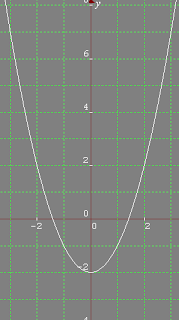Today we learned about the change of base formula; also, it was semester day 40, so we are halfway in. Mr. Max believes that we should work hard at our accelerated math and do the relevant sheets before the test. If we were to do that, we'd do so much better on the test. If you're a little behind on the sheets for our upcoming test, that's fine. You could always get caught up before the next test, and keeping on top of accelerated math would make things less stressful.
log
bn = log
an / log
ab
As long as we follow the pattern of the formula, you can make it workable on any base you choose.
given y = log
2 3
can be rewritten as:
y = log
10 3 / log
10 2
How to we evaluate? We can either use our calculator and get y~ 1.585 . . .
Or, we can use logs. (No kidding, eh!)
y = log
2 3
change to an exponential expression.
2^y = 3
then we apply the def of logs: log(2^y) = log3
y = log
10(3) / log
10(2)
ex. Solving exponential equation.
Solve:
2(3^x) = 5
CAVEAT! (A latin word that means "warning" or "beware"):
log (x + 3) != (not equal to) log
x + log
3instead, it becomes:
log(2(3^x)) = log
5log
102 + log
103^x = log5
log2 + x * log3 = log5
x * log3 = log5 - log2
x = log5 - log2 / log3 (at this point, we cannot continue without a calculator)
x = .8340437671
to check out answer: 2 * 3 ^ .8340437671 = 5
We just solved our very first exponential equation!
Let's solve another one:
19^(x - 5) = 3^(x+2)
log 19 ^ (x - 5) = log 3^(x+2)
Our reason for doing the log is to bring the exponents down.
x * log19 - 5 * log19 = x * log3 + 2 * log
(x - 5) * log 19 = (x + 2) * log 3
x * log19 - 5 * log19 = x * log3 + 2 * log3
x * (log19 - log3) = 2 * log3 + 5 * log19
x = 2 * log3 + 5 * log19 / (log19 - log3) (now we use our calculator)
x ~ 9.166
log
2 (x - 2) + log
2(x) = log
23
log
2(x - 2)(x) = log
23
x - 2(x) = 3 (we can remove the logs since they have the same base)
x ^ 2 - 2x - 3
(x + 1)(x - 3) = 0
x = -1, x = 3
STOP!
x = -1
doesn't solve the equation.
x = 3 works, though
(On a wholly unrelated note, they killed of cookie monster and turned him into . . . veggie monster. Since when did political correctness have to start and destroy our childhood memories? Is nothing sacred?!)
log5(3x + 1) + log(x - 3) = 3
log5[(3x+1)(x-3)] = 3
use definition of logs:
5 ^ 3 = (3x + 1)(x - 3)
log
ab = n
a^n = b
125 = 3x^2 - 8x -3
0 = 3x^2 - 8x - 128
(384: 16 and 24 as factors)
0 = 3x^2 - 24x + 16x - 128
0 = 3x(x-8) + 16(x-8)
0 = (3x + 16) (x - 8)
3x + 16 = 0, x - 8 = 0
x = -16/3 and x = 8
check for error:
- 16 /3 isn't a solution because after we plug it in, there is no value that 5 ^x that would be equal to a negative argument.
That's all for today
















